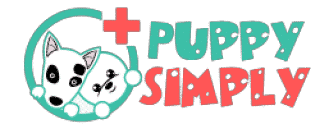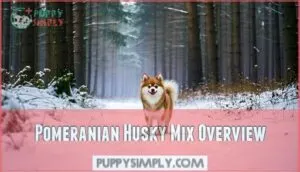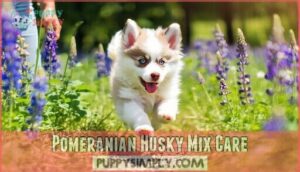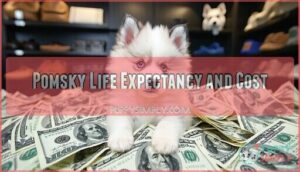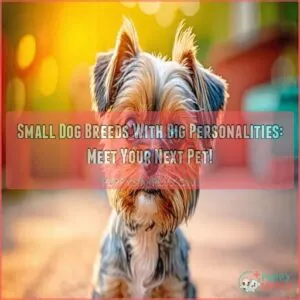This site is supported by our readers. We may earn a commission, at no cost to you, if you purchase through links.
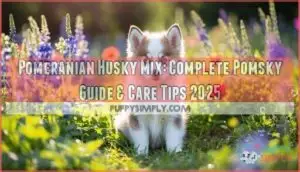 If you’re eyeing a Pomeranian Husky mix, get ready for a dog that packs big personality into a small, fluffy package.
If you’re eyeing a Pomeranian Husky mix, get ready for a dog that packs big personality into a small, fluffy package.
The Pomsky blends the Pomeranian’s sass with the Husky’s smarts, giving you a playful, energetic companion who’s always up for a walk—or a bit of mischief.
Expect a double coat, plenty of shedding, and a need for daily exercise to burn off steam.
Training’s a must, thanks to their clever streak, but you’ll find their loyalty and affection worth every treat.
Curious about grooming hacks or what makes Pomskies tick? There’s more to uncover about this pint-sized dynamo.
Table Of Contents
- Key Takeaways
- Pomeranian Husky Mix Overview
- Parent Breeds and History
- Pomsky Temperament and Personality
- Pomeranian Husky Mix Care
- Training and Socialization
- Pomsky Life Expectancy and Cost
- Finding a Pomeranian Husky Mix
- Frequently Asked Questions (FAQs)
- What is a pomsky husky mix?
- What is a Pomeranian husky mix?
- How do you breed a Pomeranian husky mix?
- Can a Huskie mate with a Pomeranian?
- How much does a Pomeranian husky mix cost?
- Is a Pomeranian mix a hybrid?
- Are Pomeranian Husky Mixes Hypoallergenic?
- How Big Do Pomeranian Husky Mixes Typically Grow?
- What is the Average Lifespan of a Pomeranian Husky Mix?
- Do Pomeranian Husky Mixes Require a Lot of Exercise?
- Conclusion
Key Takeaways
- You’ll get a playful companion with a Pomsky, but be ready for high energy and daily exercise needs.
- Regular grooming is a must since Pomskies shed heavily and have thick double coats that require frequent brushing.
- Training and early socialization are crucial to manage their intelligence, stubborn streak, and vocal tendencies.
- Expect a lifespan of 12–15 years and annual costs between $1,500–$2,500, including food, vet care, and grooming.
Pomeranian Husky Mix Overview
You’re considering a Pomeranian Husky mix, one of the most striking designer dogs that combines the best traits of two beloved breeds.
This energetic crossbreed brings together the Pomeranian’s compact charm with the Siberian Husky’s adventurous spirit, creating a loyal companion that’s as intelligent as it’s beautiful.
Hybrid Breed Characteristics
When you’re considering a Pomsky, you’re looking at fascinating trait inheritance from two distinct breeds.
This hybrid breed showcases remarkable genetic diversity, contributing to hybrid vigor that often means fewer health issues.
Size variation is striking—your Pomeranian Husky mix might weigh anywhere from 10 to 30 pounds.
Coat characteristics range from fluffy double coats in multiple colors to unique eye combinations.
These physical characteristics create unpredictable yet charming companions, while inherited behavior traits blend Pomeranian spunk with Husky independence.
Intelligence and Energy Levels
Your Pomsky’s brainpower matches their boundless energy, creating an intelligent dog that needs both mental and physical outlets.
These playful dog companions experience intense energy bursts that require strategic management through targeted activities.
Mental Stimulation becomes your secret weapon for managing their high intelligence and energy levels.
- Problem Solving puzzles that challenge their quick minds
- Exercise Needs met through interactive games and agility courses
- Training Challenges turned into fun learning sessions with consistent practice
Due to their mixed breeding, coat colors can vary.
Affectionate Personalities
Beyond their high-energy intelligence, you’ll discover your Pomsky’s heart-melting affection. These loyal companions form deep bonding behaviors with their families, displaying attachment styles that make them excellent family pets.
Pomskies are little shadows, following your every step and wrapping you in endless, joyful devotion.
Your affectionate Pomsky will follow you everywhere, showcasing classic "velcro dog" tendencies while meeting their emotional needs through constant interaction.
Their affection display creates wonderful family dynamics, making these playful dogs irresistible companions who thrive on love and attention.
Parent Breeds and History
Understanding your Pomsky’s heritage helps you better predict their traits and care needs. These designer dogs combine two distinct breeds with fascinating histories that shaped their unique characteristics.
Pomeranian Origins
Where did your fluffy companion’s Pomeranian ancestry begin?
These pint-sized charmers trace their ancient ancestry back to the German Spitz lineage, originating through European development across various regions.
Queen Victoria’s fascination in the 1800s transformed these working dogs into beloved toy breeds, though breed ambiguity surrounds their exact origins.
Key aspects of Pomeranian heritage include:
- Spitz heritage from Arctic working dogs
- Size reduction from larger farm helpers
- Royal patronage boosting popularity
- European development across multiple regions
- Transformation into companion animals
Siberian Husky Origins
Thousands of years ago, the Chukchi people of Northeast Asia developed these remarkable Arctic adaptation specialists.
Your Pomeranian Husky mix carries this ancient ancestry through its Siberian Husky parent.
These legendary sled dogs survived brutal conditions, showcasing incredible breed development that shaped today’s resilient working dogs with unmatched endurance and strength.
Breeding Process and Challenges
Creating Pomskies requires more than wishful thinking. Artificial insemination becomes necessary due to dramatic size differences between parent breeds. Responsible breeders face significant breeding challenges that demand expertise and patience.
- Genetic compatibility testing prevents hereditary health issues
- Size matching considerations guarantee safe pregnancies
- Breeder responsibility includes thorough health screenings
Ethical concerns around genetic diversity drive quality breeders to establish strict breed standards. To guarantee ethical breeding practices, one should inquire about the breeder’s breeding experience. They prioritize healthy outcomes over profit, making artificial insemination procedures safer for both mother and puppies.
Pomsky Temperament and Personality
You’ll discover that Pomskies blend the best personality traits from both parent breeds, creating dogs that are intelligent, loyal, and surprisingly vocal.
Understanding their temperament helps you prepare for a companion that’s both affectionate and independent, with strong protective instincts that make them excellent watchdogs.
Sociable Traits
Pomskies bring the party wherever they go, thriving on family compatibility through their extroverted personality.
A Pomsky turns every day into a family celebration with their playful spirit and outgoing charm.
These sociable pups form affectionate bonds with everyone, making them excellent family dogs.
Their playful nature shines during interactions, while socialization importance can’t be overstated—early exposure helps these affectionate, loyal companions develop into well-rounded pets who genuinely enjoy human company.
Intelligence and Trainability
Beyond their social nature, your Pomsky’s intelligence truly sets them apart as remarkable companions.
These intelligent dogs combine sharp problem-solving abilities with impressive learning speed.
Here’s what makes their cognitive abilities exceptional:
- Training methods work effectively due to their quick comprehension of commands
- Problem-solving skills shine through complex puzzle toys and challenges
- Learning speed accelerates with consistent positive reinforcement techniques
- Cognitive enrichment prevents boredom while managing natural stubbornness levels
However, their intelligence comes with occasional stubbornness that requires patient, consistent pomsky training approaches.
Barking and Protective Instincts
Your Pomsky will sound off whenever they spot something suspicious, combining their protective nature with barking tendencies inherited from both parent breeds.
Early training and socialization importance can’t be overstated – these vocal pups need guidance to prevent excessive barking and territorial behavior.
Without proper boundaries, their guard dog instincts might trigger anxiety or aggressive behavior around strangers.
| Trigger | Bark Intensity | Training Solution |
|---|---|---|
| Strangers at door | High volume | Redirect command training |
| Other dogs passing | Medium pitch | Controlled exposure walks |
| Delivery trucks | Persistent howling | Desensitization exercises |
| Family returning | Excited yapping | Calm greeting practice |
| Nighttime sounds | Alert barking | Quiet command reinforcement |
Pomeranian Husky Mix Care
Caring for your Pomsky requires understanding their unique blend of Pomeranian and Husky needs, from managing their thick double coat to meeting their exercise demands.
You’ll need to stay on top of regular grooming, provide adequate physical activity, and watch for breed-specific health issues that can affect these energetic designer dogs, including their exercise demands.
Exercise Needs and Recommendations
Your Pomsky’s energy levels demand strategic daily activity to keep them happy and healthy.
These spirited pups need 30-45 minutes of exercise combining brisk daily walks with mental stimulation through puzzle toys and training sessions.
Here are five ways to meet your Pomsky’s exercise needs:
- Morning power walks – Start each day with a 20-minute brisk walk to burn off that enthusiastic morning energy
- Interactive play sessions – Use fetch, tug-of-war, and agility games to challenge both body and mind
- Puzzle feeders and treat toys – Transform mealtime into mental stimulation that satisfies their intelligent nature
- Varied terrain adventures – Mix up routes with hills, trails, and different surfaces to keep walks interesting
- Indoor exercise alternatives – Create obstacle courses or play hide-and-seek for rainy day dog exercise
Consider utilizing enrichment through toys to keep your Pomsky engaged.
Adjust exercise intensity based on age – puppy exercise should be gentler with shorter bursts, while senior exercise focuses on maintaining mobility without overexertion.
Grooming Requirements and Shedding
Your fluffy friend’s thick double coat needs regular attention to stay healthy and manageable.
Pomsky grooming requirements include frequent coat brushing to control heavy shedding, especially during seasonal changes when they blow their undercoats. A proper deshedding brush matters for Pomsky coats.
- Daily brushing during shedding seasons with a deshedding brush prevents matting
- Weekly baths keep their coat clean without stripping natural oils
- Professional grooming every 6-8 weeks maintains ideal coat health and nail trimming
Common Health Concerns and Issues
Health complications can stack up like dominoes with this hybrid.
Luxating patellas and hip dysplasia top the concern list, while dental problems and eye diseases follow closely.
Your Pomsky’s genetic diversity helps, but inherited disorders still lurk.
Smart owners invest in genetic testing early—it’s your crystal ball for pomsky health issues down the road.
Training and Socialization
Training your Pomsky requires patience and consistency since these intelligent dogs inherit both the Husky’s independent streak and the Pomeranian’s occasional stubbornness.
You’ll need to establish yourself as the pack leader early while using positive reinforcement techniques to build trust and encourage good behavior.
Positive Reinforcement Techniques
Training your pomsky becomes effortless when you use positive reinforcement consistently.
Clicker training creates instant communication, while treat rewards and verbal praise reinforce good behavior immediately.
Toy motivation works perfectly for play-driven pomskies.
This reward-based training approach shapes behavior naturally, making dog training sessions enjoyable for both you and your furry companion.
Many owners find success using positive clicker methods.
Establishing a Clear Pack Order
Your Pomsky’s success depends on consistent rules and assertive leadership that establishes clear boundaries.
Think parent, not dictator—you’re setting the dominance hierarchy through calm confidence.
Use boundary setting with predictable routines and steady expectations.
Respect training means your pup learns you’re the reliable decision-maker through patient, leadership styles that build trust, not fear.
To effectively communicate expectations, it’s beneficial to teach basic commands.
Socialization With Other Pets and People
Your Pomsky’s social journey begins with early exposure to diverse situations during puppyhood.
Schedule regular playdates with friendly dogs to build confidence and teach appropriate play behavior.
When handling anxiety around new people, use treats and praise to create positive human connections.
Focus on family integration by having household members participate in feeding and training.
Consider breed compatibility when introducing other pets – Pomskies generally adapt well with proper socialization training that builds lasting social connections.
Pomsky Life Expectancy and Cost
Before considering a Pomsky, you’ll want to know what you’re committing to financially and time-wise.
These designer dogs typically live 12-15 years and can cost $1,500-$5,000 annually when you factor in food, vet bills, grooming, and unexpected health issues.
They require a significant investment, with expenses including food, vet bills, and unexpected health issues.
Average Lifespan of Pomskies
Your furry friend’s pomsky lifespan typically spans 12-15 years with proper care.
Genetic health from both parent breeds plays a major role, while diet impact and exercise influence substantially affect life expectancy.
Quality healthcare access and ideal living conditions help maximize their average lifespan.
Key factors affecting your Pomsky’s longevity:
- Genetic Factors – Inherited traits from Pomeranian and Husky lineage
- Diet Impact – High-quality nutrition prevents obesity-related health issues
- Exercise Influence – Regular activity maintains joint and cardiovascular health
- Healthcare Access – Routine vet visits catch problems early
Estimated Annual Cost of Ownership
Everyone worries about their wallet when bringing home a Pomsky. Your annual budget should range from $1,500 to $2,500 for complete care.
| Expense Category | Annual Range | Key Components |
|---|---|---|
| Food Costs | $250-$600 | Premium kibble, treats, supplements |
| Veterinary Care Costs | $420-$1,050 | Exams, vaccines, preventive medications |
| Grooming Costs | $340-$740 | Professional sessions, at-home supplies |
Pet insurance plans can offset unexpected vet expenses, while toy replacement and training add another $200-$400 annually to your cost of ownership.
Factors Affecting Cost and Lifespan
Your pomsky price and pomsky lifespan depend on multiple interconnected factors.
Breeder reputation directly impacts initial costs, while genetic predispositions from parent breeds affect long-term healthcare expenses.
Lifestyle factors like diet quality, exercise consistency, and preventative care substantially influence your dog’s longevity.
Premium nutrition and regular veterinary care costs increase cost of ownership but often extend lifespan by preventing common health concerns early.
A pomsky’s longevity is influenced by genetic and environmental factors.
Finding a Pomeranian Husky Mix
You’ll find reputable Pomsky breeders through organizations like the Pomsky Club of America and International Pomsky Association, which maintain breeder directories and breeding standards.
Rescue centers and online marketplaces also offer adoption opportunities, though you’ll want to research thoroughly to avoid puppy mills and guarantee you’re getting a healthy, well-socialized pup, from a breeder who adheres to certain breeding standards.
Reputable Breeders and Associations
Trust is key when choosing a pomsky breeder—don’t let “puppy mills” pull the wool over your eyes.
Stick with reputable breeders who meet Association Standards, like those set by The Pomsky Club of America or International Pomsky Association.
They’ll gladly show Genetic Testing results and answer questions about Ethical Breeding.
If a breeder dodges visits or seems secretive, that’s a classic Breeder Red Flag.
Ethical practices and transparency should always come first.
Online Marketplaces and Rescue Centers
You’ll often spot Pomeranian Husky mixes on online marketplaces, rescue shelters, and even dog rescue organizations’ Facebook groups.
Always double-check the adoption process, as online availability can come with marketplace risks and ethical concerns.
Rescue center platforms offer benefits, like vetting for health and temperament.
- Research rescue benefits before committing
- Watch for scams or puppy mills
- Prioritize ethical adoption practices
Considerations for Adopting a Pomsky
Before diving into pomsky adoption, weigh your Family Readiness and Lifestyle Compatibility—these pups aren’t couch potatoes.
Rescue shelters may offer Temperament Testing, helping you gauge fit. Factor in Adoption Costs, pet insurance, and the adoption process.
A little humor: if you’re allergic to vacuuming, think twice!
Here’s a quick comparison:
| Factor | Why It Matters | Quick Tip |
|---|---|---|
| Adoption Costs | Budget planning | Save for emergencies |
| Lifestyle Changes | Energy needs | Schedule daily exercise |
| Rescue Options | Ethical choice | Ask about Temperament Testing |
Frequently Asked Questions (FAQs)
What is a pomsky husky mix?
Ever wonder if opposites really do attract?
You’ll find out with this mix—a designer dog blending the playful Pomeranian and the adventurous Siberian Husky.
You get a fluffy, smart, vocal companion, full of personality and charm.
What is a Pomeranian husky mix?
You’re looking at a Pomsky—a playful, clever mix of Pomeranian and Siberian Husky.
These pups pack Husky looks into a smaller, fluffier package.
They’re energetic, loyal, and love attention, but watch out—they can be vocal!
How do you breed a Pomeranian husky mix?
To breed a Pomeranian Husky mix, you’ll need artificial insemination—Pomeranian males can’t safely mate with Huskies.
Work with an experienced vet, prioritize health screenings, and expect a small litter with lots of personality!
Can a Huskie mate with a Pomeranian?
Think of a mouse and an elephant trying to dance—the size gap between Huskies and Pomeranians is just too big for natural mating.
Breeders use artificial insemination to safely create Pomeranian Husky mixes, called Pomskies.
How much does a Pomeranian husky mix cost?
You’ll usually pay between $1,500 and $5,000 for a Pomeranian Husky mix, depending on the breeder, pedigree, and appearance.
Don’t forget to budget for supplies, vet visits, and that inevitable collection of squeaky toys!
Is a Pomeranian mix a hybrid?
Yes, a Pomeranian mix is a hybrid, meaning it’s a cross between a Pomeranian and another breed.
You’re getting a blend of two worlds—think of it as a canine mash-up with unique traits.
Are Pomeranian Husky Mixes Hypoallergenic?
You won’t find a hypoallergenic friend in a Pomeranian Husky mix.
Their thick double coat sheds a lot, so if you’re allergic, expect some sneezes and fur tumbleweeds rolling across your living room floor.
How Big Do Pomeranian Husky Mixes Typically Grow?
You’ll find these pups stand about 10 to 15 inches tall and tip the scales between 15 and 30 pounds.
They’re like pocket-sized Huskies—compact, fluffy, and ready to steal the spotlight at the dog park.
What is the Average Lifespan of a Pomeranian Husky Mix?
You can expect a Pomeranian Husky mix to stick around for 12 to 15 years.
With regular vet checkups, a balanced diet, and daily exercise, your Pomsky’s likely to be your loyal sidekick for years.
Do Pomeranian Husky Mixes Require a Lot of Exercise?
Nearly 30 minutes of daily exercise keeps your energetic pup from bouncing off the walls.
You’ll want to mix walks with playtime and puzzles—otherwise, they’ll find creative ways to redecorate your living room, Husky-style!
Conclusion
Imagine dialing up a rotary phone to chat about the Pomeranian Husky mix—these dogs bring classic charm with a modern twist.
If you’re ready for daily walks, regular grooming, and a bit of stubborn intelligence, a Pomsky can be a loyal, energetic companion.
Keep their minds busy, and you’ll enjoy a happy, healthy pet.
Research breeders or rescues carefully, and remember, a little preparation goes a long way with this unique hybrid breed.
